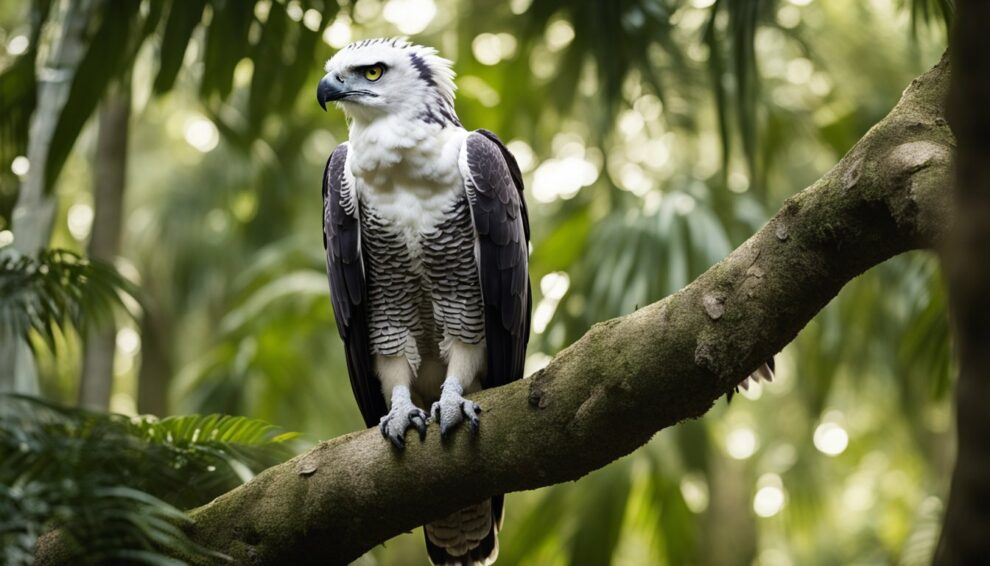The Harpy Eagle reigns supreme as the dominant predator of the rainforest canopy, where the bustle of life rises from the forest floor to the emergent treetops.
With wings that stretch up to two metres and equipped with talons comparable to the claws of a bear, they are the largest and most powerful raptors soaring through their range.
Imagine a bird so mighty that it can effortlessly snatch a monkey or a sloth from the treetops; that’s the Harpy Eagle for you.

Nests of these majestic birds are an impressive sight, often found high in the canopy, cradled by robust branches strong enough to support their large size.
While the rainforest is a treasure trove of biodiversity, the Harpy Eagle’s presence is a barometer of forest health.
Their dependence on vast tracts of undisturbed forest makes them vulnerable, yet they play a crucial role in maintaining the delicate balance of their ecosystem.
Have you ever wondered what it’s like to glide between trees with the agility of a Harpy Eagle?
These birds have a unique view of the world, where every flap of their mighty wings takes them across a green sea of leaves and life, staying hidden but ever-watchful for their next meal.
It’s a world of fierce survival, where Harpy Eagles sit at the top of the food chain, making sure the rainforest’s story continues, one swoop at a time.
The Harpy Eagle’s Realm
The Harpy Eagle reigns supreme in the dense rainforests of the Americas, a testament to the complexity and grandeur of these ecosystems.
Their kingdom is vast, sweeping through territories that exemplify nature’s untamed beauty.
Habitat and Distribution
Harpy Eagles make their homes in a region known as the neotropics, preferring vast stretches of uninterrupted rainforest.
They are notoriously difficult to spot, as they blend into their habitat across Central and South America, with significant populations in Brazil and Panama.
The Amazon rainforest, a zenith of biodiversity, is often the backdrop for their nests, which they build high within the emergent layer, amidst trees like the mighty kapok.
Rainforests are not just their home; they are a part of a living, breathing ecosystem that depends on each of its parts to thrive, from the smallest insect to the mightiest raptor.
Anatomy of a Forest Hunter
Imagine a bird with a wingspan of up to 2 meters, equipped with massive talons capable of plucking larger prey right from the rainforest canopy.
Their abbreviated wings allow for deft navigation through dense foliage, and their long tails provide precision steering.
These majestic birds, with their regal crests, embody power and precision.
They use their keen hearing, aided by a concave facial feather arrangement, to detect the movements of reptiles, mammals, and other birds upon which they prey.
Harpy Eagles are the very definition of an apex predator — commanding, competent, and crucial to their habitat.
Nesting and Reproduction
A Harpy Eagle’s nest is not merely a structure of twigs and branches.
It’s a cradle of life, set high in trees like the ceiba pentandra, symbolizing both continuation and stability.
The female lays a clutch of usually one or two eggs, focusing her efforts on a single offspring.
Harpy Eagles are monogamous, often mating for life, and share the duties of incubation and rearing.
From egg to full sexual maturity, it’s a lengthy journey of up to 5 or 6 years, showcasing the investment Harpy Eagles make in the survival of their species.
The longevity of their care ensures the forest remains under the watchful guard of these winged sentinels for generations to come.
The Harpy Eagle Diet: Masters of the Hunt

The harpy eagle is a formidable force within the rainforest, particularly renowned for its hunting prowess.
These birds of prey are top predators, playing a critical role in maintaining the delicate balance of the ecosystem.
Prey and Hunting Techniques
Harpy eagles have a diverse menu, consisting largely of tree-dwelling mammals such as sloths and a variety of monkeys, which are active during the day – that’s what we call diurnal.
Not just mammals, though; they will also catch and feast on reptiles like iguanas and snakes.
Occasionally, a porcupine, coati, or agouti might become a meal.
Here’s something interesting: these eagles don’t hunt in flights of fancy. Instead, they employ stealth and surprise.
Perched silently, they might wait for hours before launching a sudden and powerful attack on an unsuspecting animal.
With their sharp talons, they seize their prey with precision.
Harpy eagles can lift animals weighing up to their own body weight—that’s around 11 pounds for males and up to 20 pounds for females!
The Circle of Life: Impact on the Ecosystem
So how does the mighty harpy impact its home, the rainforest?
Well, they’re what scientists call a “keystone species.” That means their presence and hunting habits affect many other animals and plants, which shows just how connected everything in nature is.
By preying upon animals that eat tree leaves and seeds, harpy eagles control their populations, ensuring that no species dominates the rainforest – not too many leaf eaters, nor too few.
This helps maintain a rich tapestry of plant and animal life we call biodiversity. Remember those monkeys and sloths?
They’re important for spreading seeds, too, which helps new plants to grow. It’s all connected!
The way harpy eagles hunt – swooping down instead of soaring high – also shapes the animal behavior in the rainforest.
Smaller animals might stay hidden more, which affects when and where they move and feed.
Isn’t it incredible how one bird can influence so many parts of its home?
Conservation: Ensuring the Harpy Eagle’s Future

The harpy eagle is an apex predator that reigns over the rainforest canopy, but its future hangs in a delicate balance due to human activities.
The survival of this majestic bird hinges on effective conservation efforts.
Threats to Survival
The harpy eagle faces severe threats primarily due to deforestation and habitat loss, which stem from activities like logging and agriculture expansion.
With their homes in lowland rainforests like Darien and Mato Grosso increasingly under threat, the population of these birds is dwindling.
Important nesting trees are lost to development, reducing the breeding success of the species.
Furthermore, they are also sometimes hunted, despite being a national bird and cultural symbol in some countries.
Moreover, their large home ranges mean that harpy eagles require extensive tracts of forest to thrive, making them vulnerable to ecosystem disturbances.
Protective Measures and Human Impact
In a quest to reverse the harpy eagle’s endangered status, organizations such as the Peregrine Fund have undertaken conservation initiatives like reintroduction programs, which involve raising eagles in captivity—sometimes even in zoos—and releasing them into their natural habitat.
This strategy bolsters the population in areas where the species has declined.
Additionally, efforts to preserve existing rainforest habitats are essential to providing the harpy eagle with the ecosystem it requires.
Ecotourism is a promising avenue for conservation, turning the harpy eagle into an ambassador for its environment and encouraging protection of its habitat by showing the economic benefits of conservation.
However, human impact remains significant; it is only through continued awareness and active measures that the future for harpy eagles can be secured.
Frequently Asked Questions

In this treasure trove of trivia about the lords of the rainforest canopy, we’ll explore some intriguing details about harpy eagles—their size, diet, family life, ecological importance, conservation challenges, and their majestic flight.
How big can a harpy eagle get, and what makes them the powerhouse of the rainforest canopy?
Hefty and towering, the harpy eagle stands up to 3.5 feet tall, boasting a wingspan reaching nearly 7 feet.
Females rule the scale, typically outweighing males with an average weight of 15-20 pounds.
Their muscular build and striking talons, the size of a bear’s claw, equip them for a top status in the rainforest hierarchy, allowing them to take down sizable prey with ease.
What’s on the menu for a harpy eagle, and how do they snag a meal among the treetops?
The menu of the harpy eagle reads like a rainforest who’s who, featuring monkeys, sloths, snakes, and other tree-dwelling animals.
With precise and powerful flight, they snatch their meals from the canopy, using their immense talons to secure the catch, showcasing their hunter’s prowess among the treetops.
Could you tell me about the family life of harpy eagles, including how they raise their young?
Nurturing a single chick at a time, harpy eagle parents take turns hunting and feeding their young.
Nestled in the lofty branches, fledglings spend nearly six months under the watchful eye of their parents before spreading their wings to claim their dominion in the skies.
Why are harpy eagles considered important for the health of their rainforest home?
Harpy eagles maintain balance in their ecosystem, controlling populations of arboreal animals.
Their apex status reinforces their role as an umbrella species, meaning that protecting harpy eagles safeguards the richness and diversity of the rainforest.
What challenges do harpy eagles face today, and how can we help protect them and their habitat?
These formidable birds face the perils of deforestation and habitat loss. Preserving large swathes of rainforest and curbing illegal hunting is vital.
By fostering awareness and supporting conservation efforts, we can help ensure that the harpy eagle continues to reign over their lush kingdom.
How do harpy eagles dominate the skies with their flying abilities, and what’s their secret to soaring success?
Harpy eagles exhibit superb flying skills, capable of weaving through dense forests at speeds up to 50 miles per hour.
Their broad wings grant them the power to navigate and plunge suddenly, snagging unsuspecting prey.
This prowess in the air is no small feat, reflecting the miraculous aerodynamics of nature’s design.









